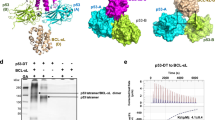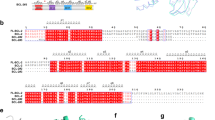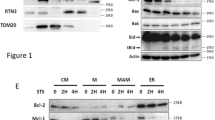Abstract
The tumour suppressor activity of the p53 protein has been explained by its ability to induce apoptosis in response to a variety of cellular stresses1,2. Thus, understanding the mechanism by which p53 functions in the execution of cell death pathways is of considerable importance in cancer biology. Recent studies have indicated that p53 has a direct signalling role at mitochondria in the induction of apoptosis3,4,5,6, although the mechanisms involved are not completely understood. Here we show that, after cell stress, p53 interacts with the pro-apoptotic mitochondrial membrane protein Bak. Interaction of p53 with Bak causes oligomerization of Bak and release of cytochrome c from mitochondria. Notably, we show that formation of the p53–Bak complex coincides with loss of an interaction between Bak and the anti-apoptotic Bcl2-family member Mcl1. These results are consistent with a model in which p53 and Mcl1 have opposing effects on mitochondrial apoptosis by interacting with, and modulating the activity of, the death effector Bak.
This is a preview of subscription content, access via your institution
Access options
Subscribe to this journal
Receive 12 print issues and online access
$209.00 per year
only $17.42 per issue
Buy this article
- Purchase on Springer Link
- Instant access to full article PDF
Prices may be subject to local taxes which are calculated during checkout





Similar content being viewed by others
References
Schuler, M. & Green, D.R. Mechanisms of p53-dependent apoptosis. Biochem. Soc. Trans. 29, 684–688 (2001).
Vousden, K.H. & Lu, X. Live or let die: the cell's response to p53. Nature Rev. Cancer 8, 594–604 (2002).
Marchenko, N.D., Zaika, A. & Moll, U.M. Death signal-induced localization of p53 protein to mitochondria: A potential role in apoptotic signaling. J. Biol. Chem. 275, 16202–16212 (2000).
Mihara, M. et al. p53 has a direct apoptogenic role at the mitochondria. Mol. Cell 11, 577–590 (2003).
Dumont, P., Leu, J.I., Della Pietra III, A.C., George, D.L. & Murphy, M. The codon 72 polymorphic variants of p53 have markedly different apoptotic potential. Nature Genet. 33, 357–365 (2003).
Chipuk, J.E., Maurer, U., Green, D.R. & Schuler, M. Pharmacologic activation of p53 elicits BAX-dependent apoptosis in the absence of transcription. Cancer Cell 4, 371–381 (2003).
Beckman, G. et al. Is p53 polymorphism maintained by natural selection? Hum. Hered. 44, 266–270 (1994).
Cory, S. & Adams, J.M. The Bcl2 family: regulators of the cellular life-or-death switch. Nature Rev. Cancer 2, 647–656 (2002).
Murphy, M. et al. Transcriptional repression by wild-type p53 utilizes histone deacetylases, mediated by interaction with mSin3a. Genes Dev. 13, 2490–2501 (1999).
Horikoshi, N. et al. Two domains of p53 interact with the TATA-binding protein, and the adenovirus 13S E1A protein disrupts the association, relieving p53-mediated transcriptional repression. Mol. Cell. Biol. 15, 227–234 (1995).
Sattler, M. et al. Structure of Bcl–xL–Bak peptide complex: recognition between regulators of apoptosis. Science 275, 983–986 (1997).
Cheng, E.H., Sheiko, T.V., Fisher, J.K., Craigen, W.J. & Korsmeyer, S.J. VDAC2 inhibits Bak activation and mitochondrial apoptosis. Science 301, 513–517 (2003).
Griffiths, G.J. et al. Cell damage-induced conformational changes of the pro-apoptotic protein Bak in vivo precede the onset of apoptosis. J. Cell Biol. 8, 903–914 (1999).
Wei, M.C. et al. tBID, a membrane-targeted death ligand, oligomerizes Bak to release cytochrome c. Genes Dev. 14, 2060–2071 (2000).
Wei, M.C. et al. Proapoptotic BAX and Bak: a requisite gateway to mitochondrial dysfunction and death. Science 292, 727–730 (2001).
Cuconati, A., Mukherjee, C., Perez, D. & White, E. DNA damage response and MCL-1 destruction initiate apoptosis in adenovirus-infected cells. Genes Dev. 17, 2922–2932 (2003).
Ruffolo, S.C. & Shore, G.C. BCL-2 selectively interacts with the BID-induced open conformer of Bak, inhibiting Bak auto-oligomerization. J. Biol. Chem. 278, 25039–25045 (2003).
Lindsten, T. et al. The combined functions of proapoptotic Bcl-2 family members bak and bax are essential for normal development of multiple tissues. Mol Cell. 6, 1389–1399 (2000).
Cheng, E.H. et al. BCL-2, BCL-xL sequester BH3 domain only molecules preventing BAX- and Bak-mediated mitochondrial apoptosis. Mol. Cell 8, 705–511 (2001).
Nijhawan, D. et al. Elimination of MCL-1 is required for the initiation of apoptosis following ultraviolet irradiation. Genes Dev. 17, 1–12 (2003).
Yang, T., Buchan, H.L., Townsend, K.J. & Craig, R.W. MCL-1, a member of the BCL-2 family, is induced rapidly in response to signals for cell differentiation or death, but not to signals for cell proliferation. J. Cell Physiol. 166, 523–536 (1996).
Bae, J., Leo, C.P., Hsu, S.Y. & Hsueh, A.J. MCL-1S, a splicing variant of the antiapoptotic BCL-2 family member MCL-1, encodes a proapoptotic protein possessing only the BH3 domain. J. Biol. Chem. 275, 25255–25261 (2000).
Kaufmann, S.H. et al. Elevated expression of the apoptotic regulator Mcl-1 at the time of leukemic relapse. Blood 91, 991–1000 (1998).
Craig, R.W. MCL1 provides a window on the role of the BCL2 family in cell proliferation, differentiation and tumorigenesis. Leukemia 16, 444–454 (2002).
Vrana, J.A. et al. An MCL1-overexpressing Burkitt lymphoma subline exhibits enhanced survival on exposure to serum deprivation, topoisomerase inhibitors, or staurosporine but remains sensitive to 1-β-D-Arabinofuranosylcytosine. Cancer Research 62, 892–900 (2002).
Chipuk, J.E. et al. Direct activation of Bax by p53 mediates mitochondrial membrane permeabilization and apoptosis. Science 303, 1010–1014 (2004).
Jimenez, G.S. et al. A transactivation-deficient mouse model provides insights into Trp53 regulation and function. Nature Genet. 26, 37–43 (2000).
Pallotti, F. & Lenaz, G. Isolation and subfractionation of mitochondria from animal cells and tissue culture lines. Methods Cell Biol. 65, 1–35 (2001).
Bessette, P.H., Aslund, F., Beckwith, J. & Georgiou, G. Efficient folding of proteins with multiple disulfide bonds in Escherichia coli cytoplasm. Proc. Natl Acad. Sci. USA 96, 13703–13708 (1999).
Hsu, Y.T. & Youle, R.J. Bax in murine thymus is a soluble monomeric protein that displays differential detergent-induced conformations. J. Biol. Chem. 273, 10777–10783 (1998).
Acknowledgements
We thank T. Lindsten and C. Thompson for the Bak+/+ and Bak−/− MEFs, and J. M. Hardwick for Bak and Bax constructs. This work was supported by US Public Health Service National Institutes of Health grants CA089240, CA080854 and 5-T32-HD07516, as well as a grant from the Department of the Army (DAMD-17-02-1-0383).
Author information
Authors and Affiliations
Corresponding author
Ethics declarations
Competing interests
The authors declare no competing financial interests.
Rights and permissions
About this article
Cite this article
Leu, JJ., Dumont, P., Hafey, M. et al. Mitochondrial p53 activates Bak and causes disruption of a Bak–Mcl1 complex. Nat Cell Biol 6, 443–450 (2004). https://doi.org/10.1038/ncb1123
Received:
Accepted:
Published:
Issue Date:
DOI: https://doi.org/10.1038/ncb1123
This article is cited by
-
Structures of p53/BCL-2 complex suggest a mechanism for p53 to antagonize BCL-2 activity
Nature Communications (2023)
-
Coiled-coil domain containing 3 suppresses breast cancer growth by protecting p53 from proteasome-mediated degradation
Oncogene (2023)
-
Low glucose metabolite 3-phosphoglycerate switches PHGDH from serine synthesis to p53 activation to control cell fate
Cell Research (2023)
-
Elephant TP53-RETROGENE 9 induces transcription-independent apoptosis at the mitochondria
Cell Death Discovery (2023)
-
MYC: a multipurpose oncogene with prognostic and therapeutic implications in blood malignancies
Journal of Hematology & Oncology (2021)



